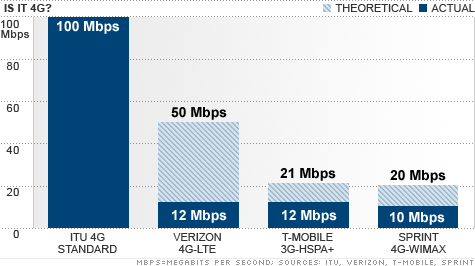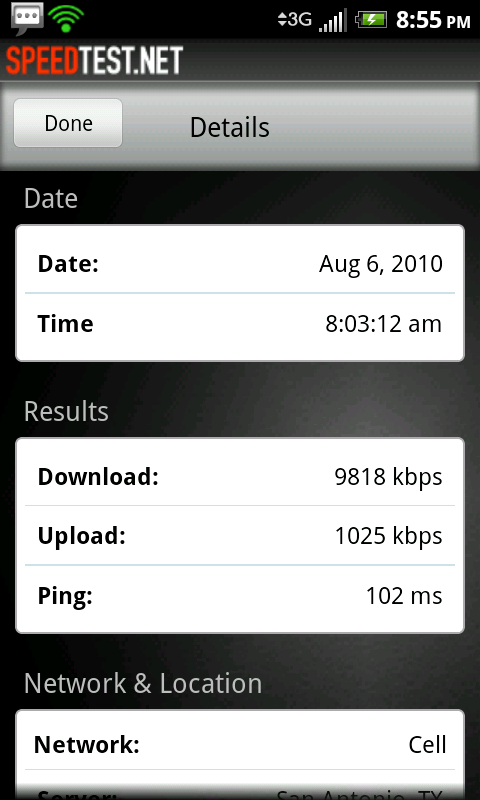http://money.cnn.com/2010/12/01/tech...myth/index.htm
thought this was a good read. especially for all the cellphone junkies out here.
4G is a myth (and a confusing mess)

thought this was a good read. especially for all the cellphone junkies out here.
4G is a myth (and a confusing mess)

NEW YORK (CNNMoney.com) -- You've seen the 4G advertisements from T-Mobile, Sprint and Verizon, bragging about a much-better wireless network with blazing fast speeds.
Here's the secret the carriers don't advertise: 4G is a myth. Like the unicorn, it hasn't been spotted anywhere in the wild just yet -- and won't be any time in the near future.
* 2950
*
*
* Email
* Print
* Comment
The International Telecommunication Union, the global wireless standards-setting organization, determined last month that 4G is defined as a network capable of download speeds of 100 megabits per second (Mbps). That's fast enough to download an average high-definition movie in about three minutes.
None of the new networks the carriers are rolling out meet that standard.
Sprint (S, Fortune 500) was the first to launch a network called 4G, going live with it earlier this year. Then, T-Mobile launched its 4G network, claiming to be "America's largest 4G network." Verizon (VZ, Fortune 500) plans to launch its 4G network next week, which it claims will be the nation's largest and the fastest. AT&T (T, Fortune 500) is expected to unveil its 4G network next year.
Those networks have theoretical speeds of a fifth to a half that of the official 4G standard. The actual speeds the carriers say they'll achieve are just a tenth of "real" 4G.
So why are the carriers calling these networks 4G?
It's mostly a matter of PR, industry experts say. Explaining what the wireless carriers' new networks should be called, and what they'll be capable of, is a confusing mess.
To illustrate: Sprint bought a majority stake in Clearwire (CLWR), which uses a new network technology called WiMAX that's capable of speeds ranging from 3 Mbps to 10 Mbps. That's a different technology from Verizon's new network, based on a standard called Long Term Evolution (LTE), which will average 5 Mbps to 12 Mbps.
Seeing what its competitors were up to, T-Mobile opted to increase the speed capabilities of its existing 3G-HSPA+ network instead of pursuing a new technology. Its expanded network -- now called 4G -- will reach speeds of 5 Mbps to 12 Mbps.
No matter what they're called, all of these upgrades are clear improvements -- and the carriers shelled out billions to make them. Current "3G" networks offer actual speeds that range from between 500 kilobits per second to 1.5 Mbps.
So Sprint and Verizon have new, faster networks that are still technically not 4G, while T-Mobile has an old, though still faster network that is actually based on 3G technology.
Confused yet? That's why they all just opted to call themselves "4G."
The carriers get defensive about the topic.
"It's very misleading to make a decision about what's 4G based on speed alone," said Stephanie Vinge-Walsh, spokeswoman for Sprint Nextel. "It is a challenge we face in an extremely competitive industry."
T-Mobile did not respond to a request for comment.
0:00 /0:55Sprint's 4G challenges iPhone
One network representative, who asked not to be identified, claimed that ITU's 4G line-in-the-sand is being misconstrued. The organization previously approved the use of the term "4G" for Sprint's WiMAX and Verizon's LTE networks, he said -- though not for T-Mobile's HSPA+ network.
ITU's PR department ignored that approval in its recent statement about how future wireless technologies would be measured, the representative said. ITU representatives were not immediately available for comment.
"I'm not getting into a technical debate," said Jeffrey Nelson, spokesman for Verizon Wireless. "Consumers will quickly realize that there's really a difference between the capabilities of various wireless data networks. All '4G' is not the same."
And that's what's so difficult. The term 4G has become meaningless and confusing as hell for wireless customers.
For instance, T-Mobile's 4G network, which is technically 3G, will have speeds that are at least equal to -- and possibly faster -- than Verizon's 4G-LTE network at launch. At the same time, AT&T's 3G network, which is also being scaled up like T-Mobile's, is not being labeled "4G."
That's why some industry experts predict that the term "4G" will soon vanish.
"The labeling of wireless broadband based on technical jargon is likely to fade away in 2011," said Dan Hays, partner at industry consultancy PRTM. "That will be good news for the consumer. Comparing carriers based on their network coverage and speed will give them more facts to make more informed decisions."
Hays expects that independent researchers -- or the Federal Communications Commission -- will step in next year to perform speed and coverage tests.
Meanwhile, don't expect anyone to hold the carriers' feet to the fire.
"Historically, ITU's classification system has not held a great degree of water and has not been used to enforce branding," Hays said. "Everyone started off declaring themselves to be 4G long before the official decision on labeling was made. The ITU was three to four years too late to make an meaningful impact on the industry's use of the term."
Here's the secret the carriers don't advertise: 4G is a myth. Like the unicorn, it hasn't been spotted anywhere in the wild just yet -- and won't be any time in the near future.
* 2950
*
*
* Comment
The International Telecommunication Union, the global wireless standards-setting organization, determined last month that 4G is defined as a network capable of download speeds of 100 megabits per second (Mbps). That's fast enough to download an average high-definition movie in about three minutes.
None of the new networks the carriers are rolling out meet that standard.
Sprint (S, Fortune 500) was the first to launch a network called 4G, going live with it earlier this year. Then, T-Mobile launched its 4G network, claiming to be "America's largest 4G network." Verizon (VZ, Fortune 500) plans to launch its 4G network next week, which it claims will be the nation's largest and the fastest. AT&T (T, Fortune 500) is expected to unveil its 4G network next year.
Those networks have theoretical speeds of a fifth to a half that of the official 4G standard. The actual speeds the carriers say they'll achieve are just a tenth of "real" 4G.
So why are the carriers calling these networks 4G?
It's mostly a matter of PR, industry experts say. Explaining what the wireless carriers' new networks should be called, and what they'll be capable of, is a confusing mess.
To illustrate: Sprint bought a majority stake in Clearwire (CLWR), which uses a new network technology called WiMAX that's capable of speeds ranging from 3 Mbps to 10 Mbps. That's a different technology from Verizon's new network, based on a standard called Long Term Evolution (LTE), which will average 5 Mbps to 12 Mbps.
Seeing what its competitors were up to, T-Mobile opted to increase the speed capabilities of its existing 3G-HSPA+ network instead of pursuing a new technology. Its expanded network -- now called 4G -- will reach speeds of 5 Mbps to 12 Mbps.
No matter what they're called, all of these upgrades are clear improvements -- and the carriers shelled out billions to make them. Current "3G" networks offer actual speeds that range from between 500 kilobits per second to 1.5 Mbps.
So Sprint and Verizon have new, faster networks that are still technically not 4G, while T-Mobile has an old, though still faster network that is actually based on 3G technology.
Confused yet? That's why they all just opted to call themselves "4G."
The carriers get defensive about the topic.
"It's very misleading to make a decision about what's 4G based on speed alone," said Stephanie Vinge-Walsh, spokeswoman for Sprint Nextel. "It is a challenge we face in an extremely competitive industry."
T-Mobile did not respond to a request for comment.
0:00 /0:55Sprint's 4G challenges iPhone
One network representative, who asked not to be identified, claimed that ITU's 4G line-in-the-sand is being misconstrued. The organization previously approved the use of the term "4G" for Sprint's WiMAX and Verizon's LTE networks, he said -- though not for T-Mobile's HSPA+ network.
ITU's PR department ignored that approval in its recent statement about how future wireless technologies would be measured, the representative said. ITU representatives were not immediately available for comment.
"I'm not getting into a technical debate," said Jeffrey Nelson, spokesman for Verizon Wireless. "Consumers will quickly realize that there's really a difference between the capabilities of various wireless data networks. All '4G' is not the same."
And that's what's so difficult. The term 4G has become meaningless and confusing as hell for wireless customers.
For instance, T-Mobile's 4G network, which is technically 3G, will have speeds that are at least equal to -- and possibly faster -- than Verizon's 4G-LTE network at launch. At the same time, AT&T's 3G network, which is also being scaled up like T-Mobile's, is not being labeled "4G."
That's why some industry experts predict that the term "4G" will soon vanish.
"The labeling of wireless broadband based on technical jargon is likely to fade away in 2011," said Dan Hays, partner at industry consultancy PRTM. "That will be good news for the consumer. Comparing carriers based on their network coverage and speed will give them more facts to make more informed decisions."
Hays expects that independent researchers -- or the Federal Communications Commission -- will step in next year to perform speed and coverage tests.
Meanwhile, don't expect anyone to hold the carriers' feet to the fire.
"Historically, ITU's classification system has not held a great degree of water and has not been used to enforce branding," Hays said. "Everyone started off declaring themselves to be 4G long before the official decision on labeling was made. The ITU was three to four years too late to make an meaningful impact on the industry's use of the term."



 . All I know is I can get 10mb download speeds on my "4G" which makes me very happy.
. All I know is I can get 10mb download speeds on my "4G" which makes me very happy.




 .
.


Comment